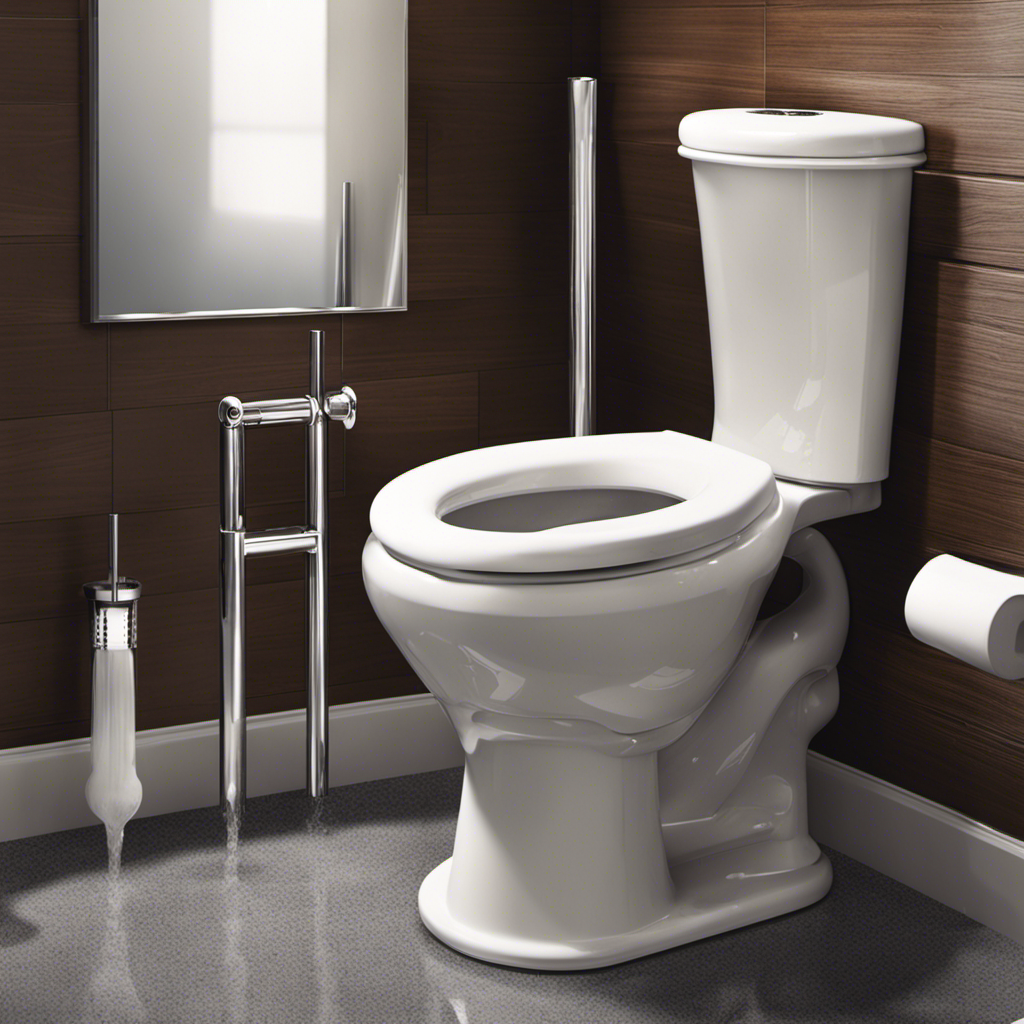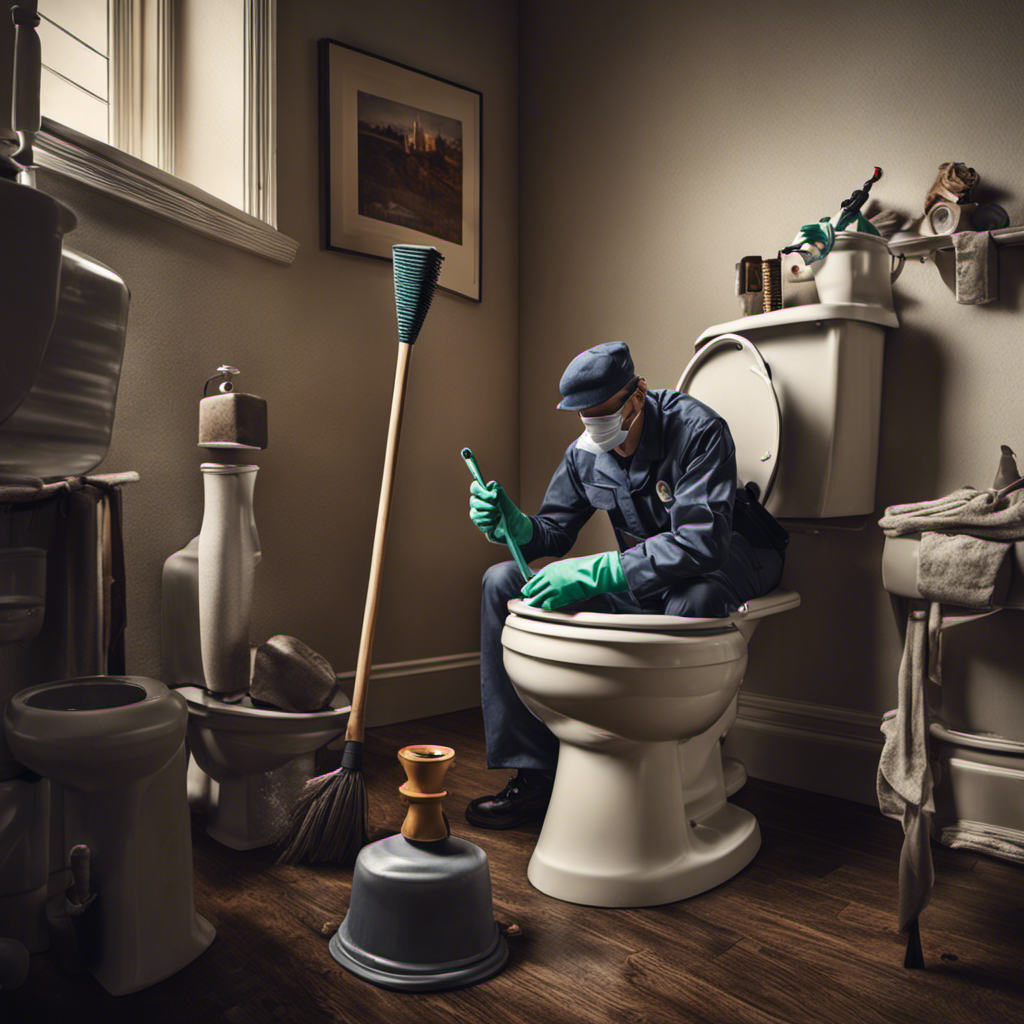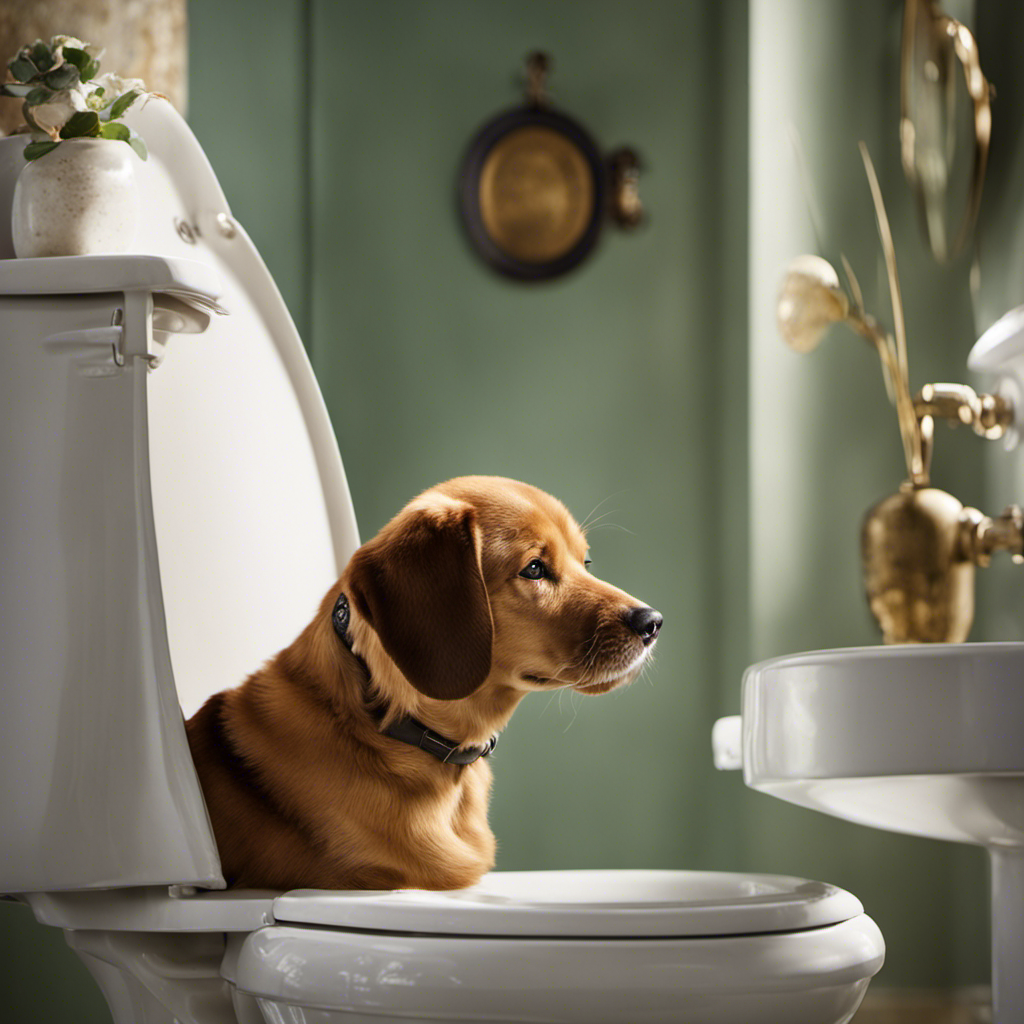I’ve been there, standing in front of a clogged toilet, feeling a mix of frustration and panic. But fear not, because I’m here to share my tried and true methods for unclogging a toilet.
In this article, we’ll cover everything from using a plunger to natural remedies, and even when it’s time to call a professional plumber.
So grab your tools, roll up your sleeves, and let’s get that toilet flowing smoothly once again.
Key Takeaways
- The tools and equipment needed for unclogging a toilet include a plunger, toilet auger, rubber gloves, bucket, and toilet brush.
- It is important to assess the severity of the clog by checking for signs such as water rising in the bowl, gurgling sounds, multiple fixtures being affected, and foul odors.
- Using a plunger correctly involves using a sturdy plunger, applying downward pressure, and using quick, forceful thrusts. Repeat if necessary.
- Alternative unclogging methods include using hot water and dish soap, baking soda and vinegar, a wire hanger, or a wet/dry vacuum. Note that these methods may not work in all situations and a toilet auger may be necessary.
- Troubleshooting common issues, taking safety precautions, and practicing preventive measures can help with unclogging and maintaining a toilet. If persistent plumbing issues occur, it may be necessary to call a professional plumber.
Tools You’ll Need
You’ll need a plunger to unclog a toilet. It is an essential tool for toilet repair and a must-have for any DIY plumbing project. When faced with a clogged toilet, a plunger is your first line of defense.
It works by creating suction and pressure to dislodge the blockage. To use it effectively, place the plunger over the drain hole and firmly push down, then pull up vigorously. Repeat this motion several times until the water starts draining.
If the plunger doesn’t work, there may be a more severe blockage that requires professional assistance. Remember to wear gloves and take necessary precautions to avoid any unnecessary mess.
With a plunger and a little know-how, you can tackle most toilet clogs on your own.
Assessing the Clog
To determine the severity of the blockage, check if water is overflowing from the bowl or if it’s draining slowly. This will help you assess the clog severity and determine the appropriate action to take.
Here are four signs of a stubborn clog to look out for:
-
Water rising in the bowl: If the water level keeps rising even after flushing, it indicates a more severe clog that needs immediate attention.
-
Gurgling sounds: If you hear gurgling sounds coming from the toilet when you flush, it suggests a partial blockage that may worsen over time if not addressed.
-
Multiple fixtures affected: If multiple fixtures, such as sinks and showers, are experiencing drainage issues at the same time, it could be a sign of a main sewer line clog.
-
Foul odors: A persistent foul smell coming from the toilet could indicate a stubborn clog that is trapping waste and causing it to decompose.
Using a Plunger
When it comes to unclogging a toilet, using a plunger is often the go-to method. However, it’s important to know the proper plunger technique to ensure success.
In this discussion, I will cover the key points of proper plunger technique, common mistakes to avoid, and alternative unclogging methods that you can try if the plunger doesn’t work.
Proper Plunger Technique
First, make sure you have a good seal between the plunger and the toilet bowl. This is crucial for effective plunging.
Here are some important tips to keep in mind for proper plunger technique:
- Use a sturdy plunger: Invest in a high-quality plunger with a rubber suction cup for better results.
- Apply downward pressure: Push the plunger down firmly to create a strong suction.
- Use quick, forceful thrusts: Pump the plunger up and down rapidly to dislodge the clog.
- Repeat if necessary: If the clog persists, continue plunging until the water starts to drain.
By following these techniques, you’ll increase your chances of successfully unclogging your toilet.
Now, let’s move on to common mistakes to avoid when using a plunger.
Common Mistakes to Avoid
Make sure you’re not pushing the plunger too forcefully, as this can cause water to splash out of the bowl.
When it comes to unclogging a toilet, there are some common mistakes that people often make. One mistake is using too much force when plunging. This can actually worsen the clog or even damage the toilet. Instead, use firm, steady pressure and a controlled motion to create suction and dislodge the blockage.
Another mistake is using the wrong type of plunger. Make sure you have a flange plunger, which has an extra piece that extends to create a better seal around the drain.
Lastly, avoid using chemical drain cleaners as they can damage your pipes and are harmful to the environment. Instead, try using a natural solution like a mixture of baking soda and vinegar to break up the clog.
Alternative Unclogging Methods
Using a plunger is a common method for clearing a clog, but there are alternative methods that can be effective as well. Here are four DIY unclogging methods that you can try before resorting to using chemicals:
-
Hot water and dish soap: Pour a pot of hot water mixed with a few teaspoons of dish soap into the toilet bowl. Let it sit for a few minutes, then flush. The soap helps lubricate the clog and the hot water can break it up.
-
Baking soda and vinegar: Sprinkle one cup of baking soda into the toilet bowl, followed by one cup of vinegar. Let it fizz for a few minutes, then flush. The combination can help dissolve and dislodge the clog.
-
Wire hanger: Straighten a wire hanger and create a small hook at one end. Insert it into the toilet drain and gently maneuver it to remove the clog by hooking onto it.
-
Wet/dry vacuum: If you have a wet/dry vacuum, you can use it to suck out the water and debris from the toilet bowl. Be sure to use the vacuum on the wet setting and avoid using it on full power to prevent any damage.
While these alternative methods can be effective, they may not work in all situations. If you’re still experiencing a stubborn clog, it may be time to consider using a toilet auger.
[Transition Sentence] If the clog persists, it may be necessary to use a toilet auger for more stubborn blockages.Using a Toilet Auger
When it comes to tackling stubborn toilet clogs, using a toilet auger can be a game-changer.
In this discussion, I will cover three key points to help you effectively use a toilet auger: proper auger technique, troubleshooting common issues, and safety precautions when using.
Proper Auger Technique
To properly unclog a toilet, it’s important to master the technique of using an auger. This handy tool can effectively remove stubborn clogs and save you from costly plumber visits. Here are four key tips for using an auger successfully:
-
Auger maintenance: Before using the auger, make sure it’s in good condition. Check for any rust or damage, and ensure the cable is properly attached.
-
Choose the right auger: There are different types of augers available, such as handheld or power augers. Select the one that suits your needs and the severity of the clog.
-
Follow the instructions: Read the manufacturer’s instructions carefully to understand how to operate the auger correctly. Improper use may damage your toilet or fail to clear the clog.
-
Avoid common auger mistakes: Don’t force the auger too forcefully or twist it vigorously, as this can cause damage. Instead, use steady and gentle pressure while rotating the auger handle.
By following these tips, you’ll be well-prepared to tackle any toilet clog.
Now, let’s move on to troubleshooting common issues to enhance your unclogging skills.
Troubleshooting Common Issues
Now that you know the proper auger technique, let’s move on to troubleshooting common issues when unclogging a toilet. Here are some helpful tips to keep in mind.
First, if the water level in the bowl is rising, quickly remove the tank lid and push down on the flapper valve to stop the flow. This will prevent an overflow.
If the toilet is not flushing properly, check the water supply valve located behind the toilet. Make sure it is fully open, allowing enough water to flow into the tank.
Another common issue is a weak flush. This could be due to a clogged rim feed or a partially closed flapper valve. Clean the rim feed holes and ensure the flapper valve is fully open.
Lastly, if you’re experiencing a gurgling sound or slow drainage, the problem might be a partial clog in the drainpipe. Use a plunger or an auger to dislodge the blockage.
Safety Precautions When Using
It’s important to take safety precautions when using an auger or plunger to avoid any potential injuries. Here are four important safety tips to keep in mind when unclogging a toilet:
-
Wear protective gloves: Toilet maintenance can be messy, so it’s crucial to protect your hands by wearing gloves. This will prevent any direct contact with bacteria or harmful chemicals.
-
Use proper posture: When using an auger or plunger, make sure to maintain a stable and balanced posture. This will help prevent any strain on your back or other muscles.
-
Avoid excessive force: While it’s tempting to use brute force, it’s important to remember that excessive force can damage the toilet or cause injury. Apply steady pressure and use controlled movements instead.
-
Be mindful of your surroundings: Before starting the unclogging process, ensure there are no obstacles or fragile items nearby that could be knocked over or broken.
Natural Remedies for Unclogging
Using baking soda and vinegar can be an effective natural remedy for unclogging a toilet. These kitchen staples can work wonders when it comes to tackling pesky clogs.
Simply pour half a cup of baking soda into the toilet bowl, followed by one cup of vinegar. Let the mixture sit for about 30 minutes, allowing it to fizz and break down the blockage. Afterward, flush the toilet and see if the clog has cleared.
This natural remedy is not only safe for your pipes but also environmentally friendly. To prevent future clogs, it’s important to be mindful of what you flush down the toilet. Avoid flushing items like wipes, cotton balls, and feminine hygiene products, as they can easily cause blockages.
Regularly maintaining your toilet by using natural remedies and practicing good flushing habits can help keep your plumbing system running smoothly.
Preventing Future Clogs
To prevent future clogs, make sure to be mindful of what you flush down the toilet. Here are four effective maintenance strategies to keep your toilet running smoothly:
-
Use toilet paper sparingly: Excessive amounts of toilet paper can easily clog your toilet. Be conscious of how much you use and flush accordingly.
-
Avoid flushing non-flushable items: Items like wet wipes, sanitary products, and paper towels are not meant to be flushed down the toilet. Dispose of them in the trash instead.
-
Regularly clean your toilet: A clean toilet is less likely to develop clogs. Use a toilet brush and cleaner to remove any buildup or residue.
-
Install a toilet strainer or trap: These devices catch debris before it enters the pipes, preventing clogs from forming.
When to Call a Professional Plumber
If you’re experiencing persistent plumbing issues, such as recurring clogs or leaks, it may be time to call a professional plumber.
While DIY solutions can be helpful for minor problems, there are instances where calling experts is the best course of action.
Professional plumbers have the knowledge, experience, and specialized tools to diagnose and fix complex plumbing issues effectively. They can also provide valuable advice on how to prevent future problems and maintain your plumbing system in good condition.
Attempting to solve complicated plumbing problems yourself can lead to further damage and costly repairs.
Frequently Asked Questions
Can I Use a Regular Plunger to Unclog a Toilet?
Yes, you can use a regular plunger to unclog a toilet. It’s important to use proper technique, applying firm pressure and creating a tight seal. If it doesn’t work, consider using alternative tools or seeking professional help.
What Should I Do if the Toilet Overflows While I’m Trying to Unclog It?
If the toilet overflows while unclogging it, first turn off the water supply valve behind the toilet. Then, use a plunger to unclog the toilet. If necessary, call a plumber for further assistance.
Is It Safe to Use Chemical Drain Cleaners to Unclog a Toilet?
Using chemical drain cleaners to unclog a toilet is not safe. They can damage the pipes and release harmful fumes. It’s better to use safer methods like a plunger or a toilet auger, which are equally effective.
How Long Does It Usually Take to Unclog a Toilet?
On average, it takes about 15-30 minutes to unclog a toilet. However, this can vary depending on the severity of the clog and the method used. Avoid common mistakes like using excessive force or flushing repeatedly.
Are There Any Alternative Methods to Unclog a Toilet if I Don’t Have a Plunger or Toilet Auger?
If you don’t have a plunger or toilet auger, there are alternative methods to unclog a toilet. One option is to use hot water and dish soap, or you can try a homemade drain cleaner using baking soda and vinegar.
Conclusion
In conclusion, unclogging a toilet can be a simple task with the right tools and techniques. By using a plunger or a toilet auger, you can effectively clear most clogs.
Natural remedies can also be helpful in loosening stubborn blockages. However, it is important to take preventive measures to avoid future clogs, such as being mindful of what is flushed down the toilet.
If all else fails, don’t hesitate to call a professional plumber for assistance. Remember, a little know-how can save you time, money, and a lot of frustration.










